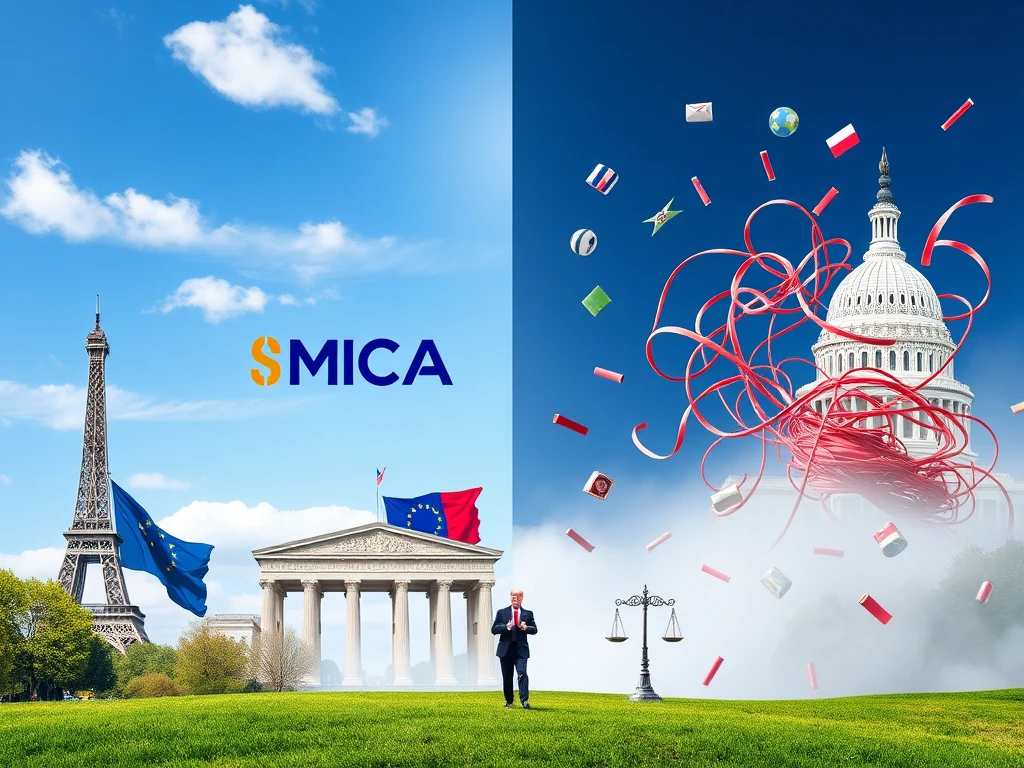MiCA: Europe’s Triumph in Crypto Regulation Over US Uncertainty

The global cryptocurrency landscape is constantly evolving, and a surprising trend is emerging: Europe is pulling ahead of the United States in attracting crypto activity. This is happening despite a seemingly crypto-friendly stance from figures like President Donald Trump in the US. The key factor? Regulatory clarity, specifically Europe’s Markets in Crypto-Assets (MiCA) framework, is driving a significant crypto market shift.
MiCA’s Clear Advantage: Why Europe Crypto is Booming
According to Konstantins Vasilenko, co-founder and chief business development officer at Paybis, the impact of MiCA has been immediate and substantial. After the regulation took effect, Paybis saw trading volumes from EU customers jump 70% quarter-on-quarter in Q1 2025. This wasn’t just more trades; Vasilenko noted that the new money was larger and more deliberate, indicating increased investor confidence.
What makes MiCA so effective? Several features stand out:
- Single Licensing Regime: Once authorized in one EU member state, crypto firms can operate across the entire bloc. This ‘passporting’ simplifies expansion and provides consistent legal protections for retail clients.
- Strict Stablecoin Rules: MiCA requires full 1:1 reserves, regular audits, and asset segregation for stablecoins, building trust in this crucial segment.
- Investor Protections: Drawing from MiFID-style rules, MiCA mandates clear disclosures, cooling-off periods, and transparent fees, reducing uncertainty and risk for users.
This clarity has prompted several major players to secure MiCA licenses, including OKX, Crypto.com, Bybit, and most recently, Coinbase in Luxembourg. The framework is clearly providing the certainty firms and investors seek.
US Crypto Market Struggles Amid Regulatory Fog
In stark contrast, the US crypto market appears to be losing momentum, particularly in retail activity. During the same period that Paybis saw EU volumes surge, their US activity trended downward. This isn’t unique to Paybis; Kaiko estimates that retail volume on Coinbase has dropped significantly since 2021, and Robinhood reported a 35% fall in crypto trading volume in Q1 2025.
Despite favorable rhetoric from some US politicians, including President Trump, concrete federal crypto regulation remains elusive. The US market is burdened by:
- State-by-State Licensing: Crypto firms often need separate money-service licenses in multiple states, creating a complex and costly compliance patchwork.
- Ongoing Legal Battles: Unresolved lawsuits from regulatory bodies like the SEC create uncertainty about which assets or services might be deemed securities or face enforcement actions.
- Lack of Clarity: Ordinary users face confusion about the legal status of various crypto assets, staking products, and even basic trading activities.
This persistent regulatory confusion acts as a significant deterrent, hindering growth and pushing activity towards clearer jurisdictions like Europe.
Pockets of Growth: France Leads Europe’s Crypto Charge
Within Europe, some countries are particularly strong performers. France, for instance, has seen a remarkable 175% spike in crypto activity on the Paybis platform. This success is partly attributed to its head start with the 2019 PACTE law, which laid early groundwork for AML registration for exchanges.
France’s proactive regulatory stance and thriving fintech ecosystem contribute to its leading position in the Europe crypto market. Other nations also play key roles; Germany is developing institutional infrastructure, while the Netherlands maintains strong payment connectivity. Under MiCA, the idea of a single crypto hub is evolving, with different functions like liquidity pools, customer support, and compliance operations potentially spread across the continent under the unified framework.
Can US Crypto Regulation Catch Up?
The future of the US crypto market isn’t sealed yet. There are legislative efforts underway, such as the GENIUS Act, which aims to introduce a unified licensing regime and clear definitions for stablecoins. If passed, this legislation could potentially provide the regulatory clarity needed to revitalize US retail crypto activity, much like MiCA has done for Europe.
The current crypto market shift towards Europe underscores a critical point: regulatory certainty is a powerful catalyst for growth and investment in the digital asset space. While the US grapples with fragmented and unclear rules, Europe’s comprehensive MiCA framework is effectively attracting both firms and users, demonstrating that clear crypto regulation is key to fostering a thriving ecosystem.








